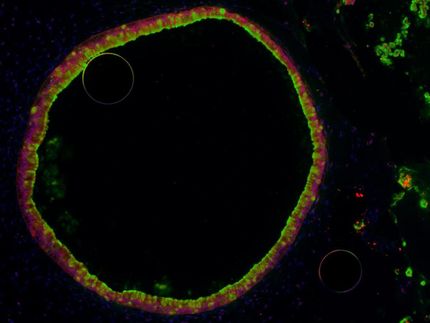Opening the cavity floodgates
Biochemists investigate the transport of large proteins through bacterial cell membranes
Every cell is surrounded by a membrane, which ensures the internal biochemical milieu and regulates the exchange of substances with its surroundings. In every cell membrane, there are a large number of transporters that allow only one sort of molecule to pass through. In the case of very small molecules, such as water, the responsible transporters form tiny pores in the membrane, which disappear immediately after the process. But how are proteins that are thousands of times larger transported through membranes without creating a large leak? In a recent study, a team led by Prof. Dr. Matthias Müller at the Institute for biochemistry and molecular biology and the special research area 746 along with Prof. Dr. Bettina Warscheid at the Institute of Biology II and the Cluster of Excellence BIOSS Centre for Biological Signalling Studies at the University of Freiburg discovered details about the structure of such a transporter for protein molecules.
The researchers studied the so-called Tat transporter that exists in the cell membrane of bacteria and exports certain proteins, the Tat substrates, out of them. The transporter consists of three components called TatA, TatB and TatC. They are distributed throughout the membrane in a resting state and only assemble into an active transporter when a Tat substrate binds to TatC. So far little is known about how the three components merge.
In a previous study, the researchers had found that the chemical dicyclohexylcarbodiimide (DCCD) blocked the Tat transport. The scientists have now identified a specific position on TatC that can be chemically altered by DCCD, which in turn inhibits contact with the Tat substrate. The position is not located on the TatC surface, but rather in a part hidden deep within the membrane. Thus, DCCD does not inhibit the primary docking of the Tat substrate, but rather its deep penetration into the membrane along the TatC molecule. Thus, the teams were able to demonstrate that the assembly of several TatC and TatB components creates a cavity in which the Tat substrate inserts from one side of the membrane. It is only in the next step, which must still be explained, that this cavity opens to the outside for which TatA is then necessary.
The Tat transporter could serve to develop new types of antibiotics in the future: Some bacteria that are harmful to human beings use the Tat transport to export protein molecules with whose help they establish contact with human host cells. Ideally, an antibiotic should only inhibit the metabolism of bacteria and not that of patients. Since the Tat transporter does not occur in human cells, it would thus be a suitable antibiotic target.

Four TatC molecules (blue) create a circle around four TatB molecules (green) to form a cavity in the center in which the protein to be transported can insert from below. Source: Journal of Biological Chemistry
Journal of Biological Chemistry
Original publication
Other news from the department science

Get the life science industry in your inbox
By submitting this form you agree that LUMITOS AG will send you the newsletter(s) selected above by email. Your data will not be passed on to third parties. Your data will be stored and processed in accordance with our data protection regulations. LUMITOS may contact you by email for the purpose of advertising or market and opinion surveys. You can revoke your consent at any time without giving reasons to LUMITOS AG, Ernst-Augustin-Str. 2, 12489 Berlin, Germany or by e-mail at revoke@lumitos.com with effect for the future. In addition, each email contains a link to unsubscribe from the corresponding newsletter.


















































